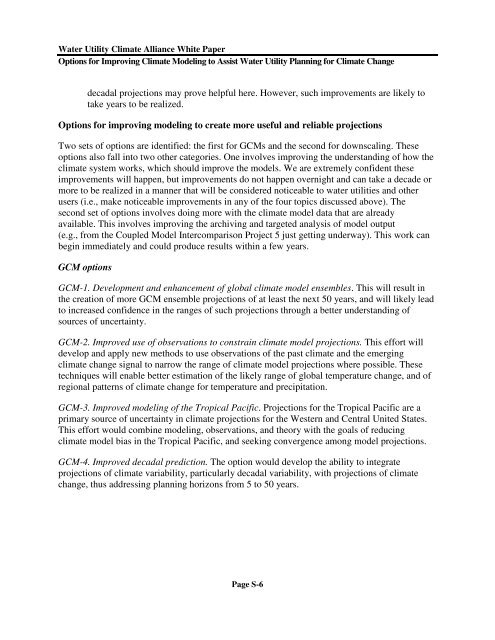Options for Improving Climate Modeling to Assist Water Utility ...
Options for Improving Climate Modeling to Assist Water Utility ...
Options for Improving Climate Modeling to Assist Water Utility ...
Create successful ePaper yourself
Turn your PDF publications into a flip-book with our unique Google optimized e-Paper software.
<strong>Water</strong> <strong>Utility</strong> <strong>Climate</strong> Alliance White Paper<br />
<strong>Options</strong> <strong>for</strong> <strong>Improving</strong> <strong>Climate</strong> <strong>Modeling</strong> <strong>to</strong> <strong>Assist</strong> <strong>Water</strong> <strong>Utility</strong> Planning <strong>for</strong> <strong>Climate</strong> Change<br />
decadal projections may prove helpful here. However, such improvements are likely <strong>to</strong><br />
take years <strong>to</strong> be realized.<br />
<strong>Options</strong> <strong>for</strong> improving modeling <strong>to</strong> create more useful and reliable projections<br />
Two sets of options are identified: the first <strong>for</strong> GCMs and the second <strong>for</strong> downscaling. These<br />
options also fall in<strong>to</strong> two other categories. One involves improving the understanding of how the<br />
climate system works, which should improve the models. We are extremely confident these<br />
improvements will happen, but improvements do not happen overnight and can take a decade or<br />
more <strong>to</strong> be realized in a manner that will be considered noticeable <strong>to</strong> water utilities and other<br />
users (i.e., make noticeable improvements in any of the four <strong>to</strong>pics discussed above). The<br />
second set of options involves doing more with the climate model data that are already<br />
available. This involves improving the archiving and targeted analysis of model output<br />
(e.g., from the Coupled Model Intercomparison Project 5 just getting underway). This work can<br />
begin immediately and could produce results within a few years.<br />
GCM options<br />
GCM-1. Development and enhancement of global climate model ensembles. This will result in<br />
the creation of more GCM ensemble projections of at least the next 50 years, and will likely lead<br />
<strong>to</strong> increased confidence in the ranges of such projections through a better understanding of<br />
sources of uncertainty.<br />
GCM-2. Improved use of observations <strong>to</strong> constrain climate model projections. This ef<strong>for</strong>t will<br />
develop and apply new methods <strong>to</strong> use observations of the past climate and the emerging<br />
climate change signal <strong>to</strong> narrow the range of climate model projections where possible. These<br />
techniques will enable better estimation of the likely range of global temperature change, and of<br />
regional patterns of climate change <strong>for</strong> temperature and precipitation.<br />
GCM-3. Improved modeling of the Tropical Pacific. Projections <strong>for</strong> the Tropical Pacific are a<br />
primary source of uncertainty in climate projections <strong>for</strong> the Western and Central United States.<br />
This ef<strong>for</strong>t would combine modeling, observations, and theory with the goals of reducing<br />
climate model bias in the Tropical Pacific, and seeking convergence among model projections.<br />
GCM-4. Improved decadal prediction. The option would develop the ability <strong>to</strong> integrate<br />
projections of climate variability, particularly decadal variability, with projections of climate<br />
change, thus addressing planning horizons from 5 <strong>to</strong> 50 years.<br />
Page S-6

















